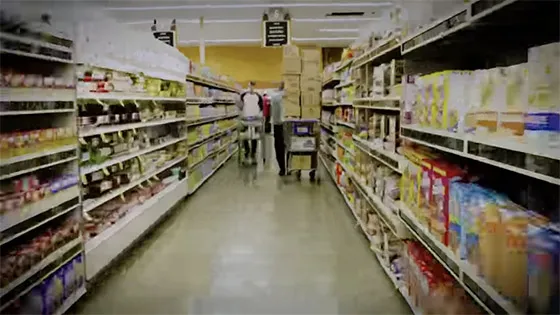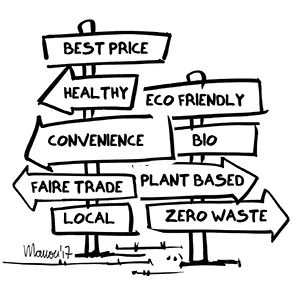About digital shelf technology:
Can smart store shelves
rescue traditional retailing?

Online and mobile shopping is still growing far more quickly than old-guard retailers, and much of that is due to consumers shopping from their couch.
As traditional retailing is struggling to keep up, questions raise of whether physical shops have any reason to exist at all. The physical point-of-sale is not dead, but there’s a risk indeed that it will become less relevant.
In the mix of efficiency, experience and expertise, traditional retail invests in innovations and technology, such as smart shop shelves. They can make visits to physical stores better or more relevant. Smart phygital puts an end to the all-powerful, all-digital retail sector and the threatened physical retail sector.
Because physical retailing hasn’t always had great experiences with breakthrough innovation, its aspirations create opportunities for brands that depend on brick-and-mortar channels.
Pilotes specializes in the design of commercial furniture, display and merchandising solutions. We offer 100% customized point-of-purchase materials tailored to the in-store projects of brand and retail. Because we care about the climate and environment, we analyze the lifecycle of each project to avoid, reduce, and offset its impact 🌍🌿
Do you have a project planned? Contact us and let’s bring your vision to life together!
The smart shelf: a vision first
“With the proliferation of technology, phygital is penetrating retail sales. Many believed that e-commerce would sweep physical shops under the table, but what emerges is a hybrid form of online and offline experiences“, Directeur Général Adjoint, Havas, Paris Retail Week.

In the Future of Shopping, shelving units, used to display and stock merchandise, are equipped with wirelessly connected technological devices, such as sensors, routers, mini-cameras, dynamic displays or Wi-Fi or Bluetooth antennas.
If we disregard the ethics for a moment, there’s unlimited possibilities to get more sales out of a smart store shelf.
- Real-time visibility on sales and automated inventory at article level, crucial for retail.
- Shopper profiling using facial recognition provides brands insight into shopper behavior at the shelf, where the large majority of transactions occurs.
- An agile platform for attention-grabbing messaging adapted to profiles of passing visitors.
- Dynamic pricing, such as time-based pricing or instant discounts based on customer profiles.
- Smartphone apps send contextual messaging according to current location.
Finally, processor power opens up the highway to analysis and in-depth knowledge about visitors, merchandising strategies, shopping behaviors, etc.
That was the future! The end of an anonymous stroll through a shop is probably a scary thought for many of us. And it will always remain tricky for retailers to get permission from visitors to follow their behavior.
On the other hand, recent innovations in discount cards (Delhaize's SuperPlus-card, Colruyt's Xtra-card) show that old-guard retailing is feeling the heat from online retail and their loyalty programs, such as Amazon Prime.
Back to the future!

The ability to see, touch and feel products ranks highest among the reasons consumers choose to shop in physical stores. And while consumer digitalization is transforming expectations (and sometimes keeping consumers away), physical retailing is increasingly offering digital services to lure consumers back to stores.
Customer-centric digital strategies, along with technology, offer opportunities for traditional retailing (and brands) to orient customer choice, advise on product features, help to sell, make the most of the (limited) store space and inventory.
At the shelf level, technology replicates relevant benefits of the online experience into physical retailing. By integrating online and offline technology, traditional retailing can offer customers a 'new retail' experience.
- Virtual extension of the instore assortment with deep product knowledge and real-time online stock at a fingertip, reducing storage costs at the same time. But 'new retail' goes further than placing a virtual shelf on the shop floor ...
- Customized and easy: consumers want dynamic interaction and meaningful experiences that reflect their preferences. And then, the new consumer wants instant gratification. He wants to be able to quickly grab the recommended products, to touch, to feel, to smell ... the most essential benefit of a physical store visit.
- One-for-all messaging makes less and less of an impression. The digital landscape has accustomed consumers to expect personal recommendations. And consumers trust contextual and relevant recommendations from influencers on social networks.
It’s relevant not to forget the visual appearance of these new shelving units. Character, made-to-measure color experiences, LED-lighting and materials can inspire a modern, dynamic image. After all, the function of each point of sale material is to get noticed, and to eventually stop hasty visitors. Design can help overcome first time use and contribute to a 'new retail' customer experience. First impressions count!
A number of uses are already popping up today in your local supermarket and specialist shop. Let’s illustrate with some cases:
Virtual shelf for Sephora

With these kiosks, equipped with a dynamic screen and wireless technology, the beauty specialist Sephora develops digital services to improve the customer's experience instore.
A catalogue app guides users through an extensive range of 14 000 products. Products that are not available in the shop can be ordered. Finally, customers can choose to have orders delivered to their home or to the shop.
Coca-Cola Mix Station on-shelf module at Carrefour
There’s nothing better than relaxing with the refreshing taste of Coca Cola. But, sometimes, you might want something a little bit stronger.
Coca Cola Signature Mixers is an exciting range of crafted mixers specially designed to be enjoyed with dark spirits, such as cognac, rum, whisky or aged tequila. Smoky, spicy, woody, herbal ... the complex flavors require a balanced mix.

This on-shelf module can be found in the liquor department of Carrefour. It is equipped with touchscreen technology. You meet the influencers Max Venning, Pippa Guy, Andriana Chia and other award-winning bartenders from legendary cocktail bars in London and Barcelona. Tell them about your preferences and they will create a unique cocktail from a library of up to 200 ingredients, and send it to your phone.
The sleek glass bottles make the Signature Mixers even more special. A pleasure to touch them at grabbing height on the shelf. This display material is a perfect example of cross-merchandising. Products from different categories are placed together for a complementary shopping experience. Success guaranteed! `
Rather than leaving consumers confused to the point of inertia in front of this complex shopping journey, Coca-Cola's Mix Station succeeds in keeping the experience exciting and fresh.
Diageo’s whisky range at Auchan can talk
Spirit producer Diageo commissioned us to develop digital strategies for its terroir-driven whisky range in supermarkets. According to preferences, region, taste, budget, time of consumption, etc, a virtual whisky master guides and orients user in 30 seconds through the extensive library.
Vertical separations, color codes with LED lighting and shelf edge communication layout a clear organization. Design and materials ensure a remarkable visual customer experience.
Wireless technology give Diageo real-time visibility on usage data. By linking them to sales, the range can be quickly adapted to a (hyper)local context.
This installation is a great way to add value to the shopping experience. How do consumers react to this new technology? Read more here about the results.
Digital wine guide (Drinkcenter Corsendonck)
A drinks retailer developed a smart wine rack that helps non-wine-specialists make a relevant wine choice quickly and easily.
"I want a wine rack that helps my customers find their bottle of wine quickly and easily. Whether you want to choose by color, country, region, grape or the dish to be combined with", Michel Keersmaekers - Corsendonck.
Users can easily enter their preferences on the touch screen ... In the connected rack, the relevant bottles light up, so people can easily find their way to the wine that meets their preference. That’s relevant experience!
Augmented reality reinvents the beauty shopping experience

If you’re shopping for beauty products, it’s difficult to make a decision without trying them on. Trying and testing products have always been the main reasons for consumers to visit beauty specialty stores.
But the ongoing pandemic are making cosmetics brands to embrace Augmented Reality (AR) to engage with their customers. In December 2020, both Google and Snapchat launched AR features to try-on makeup. They give shoppers access to virtual lipsticks and eyeshadow from L'Oréal, Estée Lauder, MAC Cosmetics, ... together with recommendations from experts and influencers. The final battle for the beauty addict has just begun.
What do you reckon? Is physical makeup testing a thing of the past? Will physical stores accelerate AR experiences on the shop floors?
Kroger And Microsoft Smart Shelves

Grocery giant Kroger integrates a cloud-based signage solution for retail shelves in 120 of its stores. The EDGE system is a cloud-based signage solution that supports full color digital imagery and video for displaying creative ads and other content, such as nutritional and allergy information, promotions and real-time prices. The system relies on Microsoft to store and process volumes of data generated by customer actions on and around the shelves.
With this technology, shoppers can compare the benefits of each product at the shelf. Bluetooth in the shelves interacts with the shopping list in their smartphone, lighting up a shelf beneath the very next item they came to fetch.
Key takeaways
By translating the unprecedented and relevant opportunities of online shopping experiences into the physical shop shelves, old-guard retailing can gain and maintain a lead on the coming 'new retail' wave, an opportunity that brands will not miss either.
Smart shop shelves are equipped today with technology that attracts and holds the attention of customers. Retailers and brands that succeed in integrating online and offline technologies on the shop floor will tap into unprecedented opportunities.
One condition: put the customer experience and the assortment first, not technology, because the offer will always magnetize the shopper eye first.
Date: March 2021 — bh
Do you wish to stimulate sales for your brand with digital strategies? Reach out today to set up a free consultation. We'll find the best solution for your brand.









